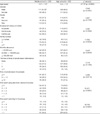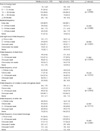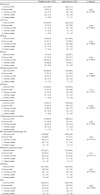1. Ministry of Health and Welfare. Korea Centers for Disease Control & Prevention. Korea health statistics 2016: Korea National Health and Nutrition Examination Survey (KNHANES VII-1). Cheongju: Korea Centers for Disease Control & Prevention;2017.
2. Ministry of Education. Ministry of Health and Welfare. Korea Centers for Disease Control & Prevention. The 13th Korea youth risk behavior web-based survey. Cheongju: Korea Centers for Disease Control & Prevention;2017.
4. Shin GN, Kim YR, Kim MH. Nutritional evaluation of convenience meals in convenience stores near the universities. Korean J Community Nutr. 2017; 22(5):375–386.

5. Pae M. Dietary habits and perception toward food additives according to the frequency of consumption of convenience food at convenience stores among university students in Cheongju. Korean J Community Nutr. 2016; 21(2):140–151.

6. Kim HY, Lee JS, Hwang JY, Kwon SH, Chung HR, Kwak TK. Development of NQ-A, Nutrition Quotient for Korean Adolescents, to assess dietary quality and food behavior. J Nutr Health. 2017; 50(2):142–157.

7. Choi MK. A study on the relationship between fast food consumption patterns and nutrition knowledge, dietary attitude of middle and high school students in Busan. Korean J Culinary Res. 2007; 13(2):188–200.
8. Yang KM. A study on the anthropometric characteristics, dietary attitudes and nutritional knowledge among high school students in Daegu area. J Glob Youth Stud. 2013; 3(2):45–65.
9. Yoon SY, Yoo HS. The effects of food and nutrition information in mass media on adolescents' dietary behaviors. J Korean Soc Integr Med. 2016; 4(2):109–120.

11. Kwon JE, Park HJ, Lim HS, Chyun JH. The relationships of dietary behavior, food intake, and life satisfaction with family meal frequency in middle school students. J Korean Soc Food Cult. 2013; 28(3):272–281.

12. Choi KI. An effect on body image of time of television watching and Internet use for academic high school students. J Adolesc Welf. 2013; 15(3):173–191.
13. Boynton-Jarrett R, Thomas TN, Peterson KE, Wiecha J, Sobol AM, Gortmaker SL. Impact of television viewing patterns on fruit and vegetable consumption among adolescents. Pediatrics. 2003; 112(6):1321–1326.

14. Ma Y, Bertone ER, Stanek EJ 3rd, Reed GW, Hebert JR, Cohen NL. Association between eating patterns and obesity in a free-living U.S. adult population. Am J Epidemiol. 2003; 158(1):85–92.

15. Park KW, Lee K, Park TJ, Kwon ER, Ha SJ, Moon HJ. The factors associated with becoming obese children: in 6th grade children of elementary schools in Busan. J Korean Acad Fam Med. 2003; 24(8):739–745.
16. Zhang L. How game addiction and smartphone addiction affects teens physical health [Master's thesis]. Myongji University;2013.
17. Lee NN. A research on the impact of eating behavior and food intake according to the gender and smartphone addiction [Master's thesis]. KyungHee University;2014.
18. Erdenebileg Z, Park SH, Park SJ, Chang KJ. Nutrition knowledge, dietary attitudes, and dietary behaviors by gender of high school students in Incheon. J Korean Soc Food Cult. 2016; 31(6):652–660.

19. Han GS, Cho WK. Study of dietary behaviors and snack intake patterns of high school students in Seoul, Incheon, and Gyeonggi-do. Korean J Food Cult. 2011; 26(5):490–500.
20. Park HR, Kim JH, Lee JH. Socio-demographic influences on adolescents' eating behavior: based on the Korean youth risk web-based survey from 2015. J Korean Diet Assoc. 2017; 23(4):397–407.
21. Yoon HS. The consumption pattern, perception and knowledge of middle and high school students on milk in Geochang area. J Korean Diet Assoc. 2006; 12(1):18–31.
22. Kim NY, Lee JS. A study on perception and utilization of food-nutrition labeling by age in Busan residents. J Korean Soc Food Sci Nutr. 2009; 38(12):1801–1810.

23. Koo HJ, Kim SY. Analysis of purchasing behaviors of processed foods in high school students in Yongin region. J Korean Soc Food Sci Nutr. 2014; 43(12):1929–1936.

24. Ko SY, Kim KW. Nutrition label use, self-efficacy, snacking and eating behavior of middle school students in Kyunggi area. Korean J Community Nutr. 2010; 15(4):513–524.
25. Jung EY, Lim YH, Park MS, Kim MW. A survey of the consumption of convenience foods. Korean J Community Nutr. 2002; 7(2):149–155.
26. Choi H, Kwon S, Yoon J. Government-funded meal support program for low-income children through convenience stores: current status and nutritional quality of available meal items in Seoul. Korean J Community Nutr. 2011; 16(2):253–264.
27. Jung LH, Kim YJ, Jeon ER. A study on snack purchasing behavior, understanding of food and nutrition labeling of middle school students in Naju area. J Korean Home Econ Educ Assoc. 2014; 26(4):1–19.
28. Kim KH. A study of the dietary habits, the nutritional knowledge and the consumption patterns of convenience foods of university students in the Gwangju area. Korean J Community Nutr. 2003; 8(2):181–191.







 PDF
PDF ePub
ePub Citation
Citation Print
Print







 XML Download
XML Download